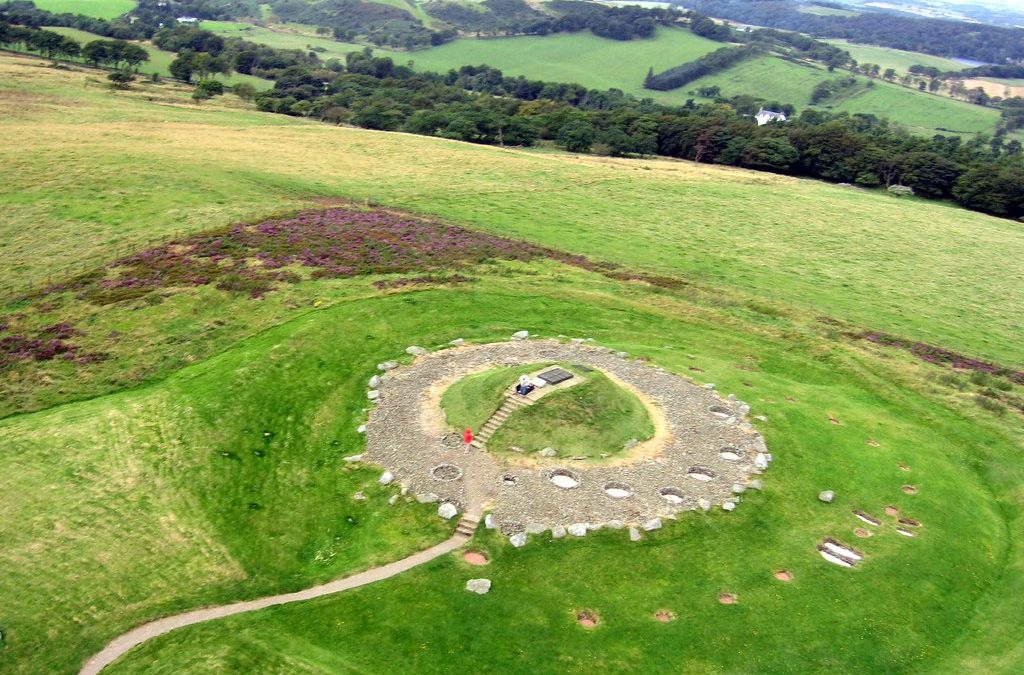Cairnpapple Hill, located in Scotland, is a historic site that has been attracting visitors for thousands of years. This ancient monument is believed to have been used for various purposes, including as a burial site, as well as for astronomical observations and religious ceremonies. The hill offers stunning views of the surrounding countryside and is an important part of Scotland’s heritage.
The hill has been the subject of extensive research and excavation, with archaeologists uncovering a wealth of information about its history and significance. Cairnpapple Hill is thought to have been used by ancient peoples as far back as 3000 BC, and it is believed that it was used for various purposes over the centuries. The site is now managed by Historic Environment Scotland, which works to preserve and protect this important part of Scotland’s history for future generations.
Visitors to Cairnpapple Hill can explore the site and learn more about its history through a variety of exhibits and displays. The hill is also home to a number of walking trails, allowing visitors to take in the stunning views of the surrounding countryside. Whether you are a history buff or simply looking for a beautiful place to explore, Cairnpapple Hill is well worth a visit.
Historical Significance
Neolithic Period
Cairnpapple Hill has a significant historical importance that dates back to the Neolithic period. During this period, the hill was used as a burial site, and several tombs were constructed on the summit. The tombs were built using large stones that were transported from nearby locations, and they were used to bury important members of the community. The tombs were constructed in a circular pattern, and they were surrounded by a ditch and a bank.
Bronze Age
During the Bronze Age, the hill was used as a religious site, and several stone circles were constructed on the summit. The stone circles were used for various ceremonies, including rituals related to the sun and the moon. The circles were constructed using large stones that were transported from nearby locations, and they were arranged in a circular pattern.
Iron Age
During the Iron Age, the hill was used as a hillfort, and several defensive structures were constructed on the summit. The defensive structures included a rampart and a ditch, which were used to protect the hillfort from attackers. The hillfort was used as a place of refuge during times of war and conflict.
Archaeological Features
Cairn and Henge
Cairnpapple Hill is home to a number of fascinating archaeological features, including a cairn and henge. The cairn is a man-made structure that is believed to have been constructed in the Neolithic period, around 5000 years ago. It is made up of small stones and measures approximately 20 metres in diameter. The cairn is thought to have been used for ceremonial purposes and may have been used as a burial site.
The henge is another important feature of Cairnpapple Hill. It is a circular enclosure that is believed to have been constructed in the Bronze Age, around 4000 years ago. The henge measures approximately 45 metres in diameter and is surrounded by a ditch and bank. It is thought that the henge was used for religious or ceremonial purposes, and may have been used as a place for public gatherings.
Standing Stones
In addition to the cairn and henge, Cairnpapple Hill is also home to a number of standing stones. These stones are believed to have been erected in the Neolithic period, around 5000 years ago. They are arranged in a circle around the cairn and are thought to have had some religious or ceremonial significance.
Henge Monument
The henge monument at Cairnpapple Hill is one of the most impressive features of the site. It is a large circular enclosure that is surrounded by a ditch and bank. The monument measures approximately 45 metres in diameter and is thought to have been used for religious or ceremonial purposes.
The henge monument is believed to have been constructed in the Bronze Age, around 4000 years ago. It is thought that it may have been used as a place for public gatherings or as a site for religious ceremonies.
Excavations and Findings
Early Excavations
The first excavations at Cairnpapple Hill were conducted by Stuart Piggott in 1947. Piggott identified a large circular ditch surrounding the summit of the hill, which he interpreted as a ceremonial complex. Inside the ditch, Piggott found a number of post holes and pits, which he believed were used for ritual purposes. Piggott also found evidence of cremation burials, including a large quantity of burnt bone and a beaker.
Subsequent excavations in the 1950s and 1960s confirmed Piggott’s interpretation of the site. The excavations revealed that the ditch had been dug in several phases, with the earliest phase dating to the Neolithic period. The post holes and pits were also found to date to the Neolithic, and were likely used for rituals and ceremonies.
Recent Discoveries
More recent excavations at Cairnpapple Hill have revealed further details about the site. In 2010, a team from the University of Edinburgh excavated a burial mound on the eastern slope of the hill. The mound was found to contain a single cremation burial, along with a number of grave goods, including a bronze dagger, a pottery vessel, and a stone axe.
In 2016, another team from the University of Edinburgh excavated a series of pits on the western slope of the hill. The pits were found to contain a large quantity of burnt bone and charcoal, suggesting that they were used for cremation burials. The pits also contained fragments of pottery and flint tools, indicating that they were used for other purposes as well.
Geographical Overview
Location and Surroundings
Cairnpapple Hill is a prominent hilltop located in West Lothian, Scotland. It is situated in the Bathgate Hills, which are part of the larger range of hills that make up the Southern Uplands of Scotland. The hill rises to a height of 312 meters (1,024 feet) above sea level and offers panoramic views of the surrounding countryside.
The hill is located near the centre of mainland Scotland, making it an ideal vantage point for observing the surrounding landscape. Cairnpapple Hill is also located near the Forth Valley, which provides stunning views of the River Forth and the nearby Bass Rock.
Views from the Summit
From the summit of Cairnpapple Hill, visitors can enjoy unparalleled views of the surrounding landscape. On a clear day, it is possible to see as far as the Arran Mountains in the west and the Central Scotland Highlands in the north.
The views from the summit of Cairnpapple Hill are particularly impressive due to the hill’s location in the Bathgate Hills. The hill is situated on a prominent ridge that rises above the surrounding lowlands, providing unobstructed views of the surrounding countryside.
Visitor Information
Visitor Centre
Cairnpapple Hill has a Visitor Centre that provides visitors with information about the history and significance of the site. The Centre houses a small exhibition that showcases some of the artifacts found on the hill, including pottery and flint tools. Visitors can also watch a short film about the history of the site and the surrounding area. The staff at the Visitor Centre are knowledgeable and can provide visitors with information about the hill and the surrounding area.
Facilities
There is a car park at the base of Cairnpapple Hill that can accommodate several cars. Visitors can park their cars here and walk up to the top of the hill. There are stone steps that lead up to the summit, and visitors are advised to wear appropriate footwear. There are no facilities at the top of the hill, so visitors are encouraged to bring their own food and drinks.
Accessibility
Cairnpapple Hill is accessible to visitors with mobility issues, but there are some steep sections of the path leading up to the summit. The Visitor Centre and car park are both accessible, and there are toilets available for visitors to use. However, visitors with mobility issues may find it difficult to climb the stone steps to the summit.
Historic Environment Scotland manages Cairnpapple Hill, and visitors are encouraged to follow their guidelines when visiting the site. Visitors are asked to respect the site and not to climb on the radio mast or the church ruins. Visitors are also asked to take their litter with them when they leave the site.

